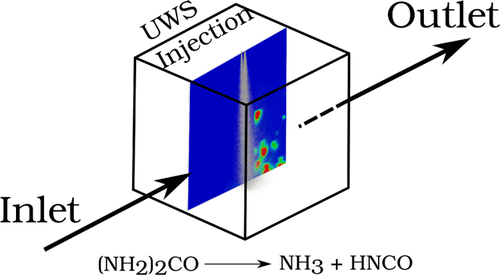当前位置:
X-MOL 学术
›
Ind. Eng. Chem. Res.
›
论文详情
Our official English website, www.x-mol.net, welcomes your feedback! (Note: you will need to create a separate account there.)
Numerical Analysis of Urea to Ammonia Conversion in Automotive Selective Catalytic Reduction Realistic Conditions
Industrial & Engineering Chemistry Research ( IF 4.2 ) Pub Date : 2021-09-23 , DOI: 10.1021/acs.iecr.1c02627 Raúl Payri 1 , Gabriela Bracho 1 , Pedro Martí-Aldaraví 1 , Javier Marco-Gimeno 1
Industrial & Engineering Chemistry Research ( IF 4.2 ) Pub Date : 2021-09-23 , DOI: 10.1021/acs.iecr.1c02627 Raúl Payri 1 , Gabriela Bracho 1 , Pedro Martí-Aldaraví 1 , Javier Marco-Gimeno 1
Affiliation

|
The selective catalytic reduction (SCR) is a technology employed for NOx reduction purposes which is based on the injection of an Urea Water Solution (UWS) into the exhaust line. Conversion of this injected urea into ammonia is a key step to ensure high SCR efficiency. In order to study this phenomenon, a three-dimensional model of the urea–water injection process has been created to recreate realistic conditions. A Lagrangian–Eulerian approach has been followed to model liquid and gas phases, respectively. Droplet evaporation as well as relevant chemical processes have been included to recreate the thermolysis and hydrolysis phenomena, and the results have been validated against literature data. Then, the validated model has been applied to recreate an in-house experimental facility that measured spray macroscopic and microscopic characteristics by means of diffused back illumination (DBI) visualization. Probability density functions of the UWS droplet sizes as well as the velocity distributions have been obtained at three different regions of interest to be compared with the experimental data set. Contours of isocyanic acid and ammonia mass fractions have been included to show the chemical transformation from urea into its products. The model accurately replicates the experimental results, and it stands as a good methodology to predict the main spray characteristics as well as the chemical processes that take place in actual SCR systems.
中文翻译:

汽车选择性催化还原现实条件下尿素向氨转化的数值分析
选择性催化还原 (SCR) 是一种用于处理 NOx 的技术基于将尿素水溶液 (UWS) 注入排气管线的减排目的。将这种注入的尿素转化为氨是确保高 SCR 效率的关键步骤。为了研究这种现象,创建了尿素水喷射过程的三维模型,以重现现实条件。采用拉格朗日-欧拉方法分别对液相和气相进行建模。已包括液滴蒸发以及相关的化学过程以重现热解和水解现象,并且结果已根据文献数据进行了验证。然后,已验证的模型已应用于重建一个内部实验设施,该设施通过漫反射背照 (DBI) 可视化测量喷雾宏观和微观特征。已经在三个不同的感兴趣区域获得了 UWS 液滴尺寸的概率密度函数以及速度分布,以便与实验数据集进行比较。已包括异氰酸和氨质量分数的轮廓,以显示从尿素到其产品的化学转化。该模型准确地复制了实验结果,是预测主要喷雾特性以及实际 SCR 系统中发生的化学过程的良好方法。已包括异氰酸和氨质量分数的轮廓,以显示从尿素到其产品的化学转化。该模型准确地复制了实验结果,是预测主要喷雾特性以及实际 SCR 系统中发生的化学过程的良好方法。已包括异氰酸和氨质量分数的轮廓,以显示从尿素到其产品的化学转化。该模型准确地复制了实验结果,是预测主要喷雾特性以及实际 SCR 系统中发生的化学过程的良好方法。
更新日期:2021-10-06
中文翻译:

汽车选择性催化还原现实条件下尿素向氨转化的数值分析
选择性催化还原 (SCR) 是一种用于处理 NOx 的技术基于将尿素水溶液 (UWS) 注入排气管线的减排目的。将这种注入的尿素转化为氨是确保高 SCR 效率的关键步骤。为了研究这种现象,创建了尿素水喷射过程的三维模型,以重现现实条件。采用拉格朗日-欧拉方法分别对液相和气相进行建模。已包括液滴蒸发以及相关的化学过程以重现热解和水解现象,并且结果已根据文献数据进行了验证。然后,已验证的模型已应用于重建一个内部实验设施,该设施通过漫反射背照 (DBI) 可视化测量喷雾宏观和微观特征。已经在三个不同的感兴趣区域获得了 UWS 液滴尺寸的概率密度函数以及速度分布,以便与实验数据集进行比较。已包括异氰酸和氨质量分数的轮廓,以显示从尿素到其产品的化学转化。该模型准确地复制了实验结果,是预测主要喷雾特性以及实际 SCR 系统中发生的化学过程的良好方法。已包括异氰酸和氨质量分数的轮廓,以显示从尿素到其产品的化学转化。该模型准确地复制了实验结果,是预测主要喷雾特性以及实际 SCR 系统中发生的化学过程的良好方法。已包括异氰酸和氨质量分数的轮廓,以显示从尿素到其产品的化学转化。该模型准确地复制了实验结果,是预测主要喷雾特性以及实际 SCR 系统中发生的化学过程的良好方法。

























 京公网安备 11010802027423号
京公网安备 11010802027423号